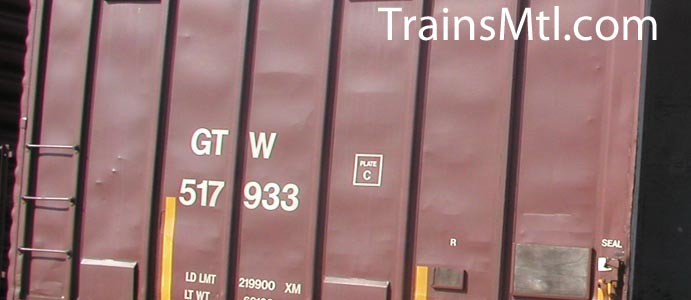
Grand Trunk
Reporting marks / Identifications : CV, CVQ, DTI, DTS, GTW,GTWQ
The Grand Trunk Railway Company of Canada (GTR) was created in 1852. Its original goal was to build a line between Montreal and Toronto.
Quickly, the line grew, following the whole length of the St-Laurent River and around the South of the Great Lake.
By 1867, the year of the confederation, The GTR was the largest railroad in the world with 1277 miles (2055km) of tracks. During its life time. The GTR had 3 large subsidiaries; Central Vermont Railway; Grand Trunk Pacific Railway and The Great Trunk Western Railway.
When the Province of British Columbia joined the Confederation of Canada in 1871 with the condition that a railroad had to be built between the newly created Province and the rest of Canada, GTR as the major railroad company was asked to build the line. They refused, which lead the creation of the Canadian Pacific Railroad by the Canadian Government to fulfill their promise
Since its creation, The GTR was under the control of British interest and from 1920 to 1923, the British investors fought to keep the control of the company despite its financial difficulties until 1923 when it was merged into the Canadian National Railway. At the time, the GTR was the owner of about 125 smaller railway companies with 8000 miles (12800km) of tracks in Canada and 1164 miles (1873km) of track in the United States.
Many of the GTR railroad lines were abandoned or sold by the Canadian National, even if Canadian national still use the name of Grand Trunk to this day. An American company was created in 1971, mostly to avoid to have to subsidise the Grand trunk Western losses and make it profitable. Grand Trunk Western Railroad; Duluth, Winnipeg, Pacific Railway; and the Central Vermont Railway were place under the management of the GT (Grand Trunk Corporation) later, Illinois Central, Wisconsin Central, and Great Lakes Transportation were added to the GT list of companies it was managing. In 1995, Vermont Central was liquidated.
Some of the great work done by Grand Trunk during its operation include the Victoria bridge, the first one to be built over the St-Lawrence River in Montreal, a bridge over the Niagara River at Fort Erie and a tunnel under the St-Clair River in Sarnia Ontario.
The Great Trunk Corporation, owned a little less than 4000 rail cars of all types.
Le “Grand Trunk Railway Company of Canada” (GTR) a été créé en 1852. Son mandate original était de bâtir une ligne entre Montréal et Toronto.
Rapidement, le réseau s’est accru, suivant le fleuve st-Laurent et le sud des Grands Lacs.
En 1867, l’année de la confédération, le GTR était le plus grand réseau ferroviaire du monde avec ses 2055 km de voies. Pendant son existence, le GTR a eu 3 filiales importantes; les Central Vermont Railway; Grand Trunk Pacific Railway and The Great Trunk Western Railway.
Quand la province de la Colombie Britannique s’est jointe à la confédération en 1871, une des conditions pour joindre la confédération était de réunir par chemin de fer la province de la Colombie Britannique avec le reste du Canada. Comme GTR était la plus grosse compagnie de chemin de fer, on leurs a demandé de créé cette ligne, ce que le GTR a refusé. Ceci a contribué de faire la création par le nouveau gouvernement de la confédération du Canadien Pacifique pour réaliser cette tâche, et permettre ainsi au gouvernement de respecter leurs promesses.
Depuis sa création, le GTR était sous la gestion d’intérêt Britannique et entre 1920 et 1923, les investisseurs Anglais se sont battus malgré les difficultés monétaires de la compagnie jusqu’à celle-ci soit fusionner au Canadien National. À ce moment, le GTR était propriétaire de plus de 125 plus petites compagnies ferroviaires comprenant 12800 km de voies au Canada et 1873 km de voies au États-Unis.
Avec les années, plusieurs lignes du GTR ont été abandonnées par le Canadien national, même si celui-ci continu d’utilisé le nom de Grand Trunk. En 1971, une filiale Américaine a été créée pour faire la gestion des intérêts du Canadien national du côté Américain, la raison était surtout d’éviter au CN d’avoir a financé les pertes du Grand Trunk Western alors et de rendre ses compagnies au sud de la frontière, profitables. Les Grand Trunk Western Railroad; Duluth, Winnipeg & Pacific Railway et Central Vermont ont été placer sous la direction du GT (Grand Trunk Corporation) et plus tard, les Illinois Central, Wisconsin Central, et Great Lakes Transportationont été ajouté. En 1995, le Central Vermont a été liquidé.
Durant son existence, le Grand trunk Railraod a réalisé certaines grandes réalisations comme; le pont Victoria, le premier à passer au-dessus du fleuve St-Laurent, le pont au-dessus de la rivière Niagara à Fort Érié, et un tunnel sous la rivière Ste-Claire à Sarnia en Ontario.
Le Grand Trunk Corporation possède un peu moins de 4000 wagons de tous types.
To go back to the companies' page / Pour retourner à la page des comnpagnies
To go back to the menu page / Pour retourner à la page du menu